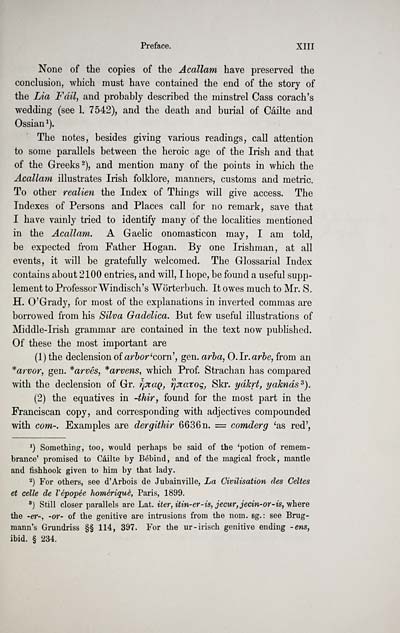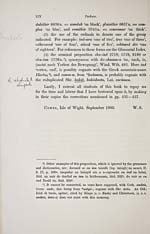Matheson Collection > Irische Texte
(17)
Download files
Complete book:
Individual page:
Thumbnail gallery: Grid view | List view

Preface. XIII
None of the copies of the Acallam have preserved the
conclusion, which must have contained the end of the story of
the lÄa Fail, and probably described the minstrel Cass corach's
wedding (see 1. 7542), and the death and burial of Cáilte and
Ossian^).
The notes, besides giving various readings, call attention
to some parallels between the heroic age of the Irish and that
of the Greeks-), and mention many of the points in which the
Acallam illustrates Irish folklore, manners, customs and metric.
To other realien the Index of Things will give access. The
Indexes of Persons and Places call for no remark, save that
I have vainly tried to identify many of the locahties mentioned
in the Acallam. A Gaelic onomasticon may, I am told,
be expected from Father Hogan. By one Irishman, at all
events, it will be gratefully welcomed. The Glossarial Index
contains about 2100 entries, and will, I hope, be found a useful suj^p-
lement to Professor Windisch's Wörterbuch. It owes much to Mr. S.
H, 'Grady, for most of the explanations in inverted commas are
borrowed from his Silva Gadelica. But few useful illustrations of
Middle-Irish grammar are contained in the text now pubUshed.
Of these the most important are
(1) the declension of ar&ör 'corn', gen, arha, O.Ir.arhe, from an
*arvor, gen. *arvés, *arvens, which Prof. Strachan has compared
with the declension of Gr. rjjcag, rjjiazog, Skr. ydkrf, yalcnas^).
(2) the equatives in -thir, found for the most part in the
Franciscan copy, and corresponding with adjectives compounded
with com-. Examples are dergithir 6636 n. = comderg *as red'.
*) Something, too, would perhaps be said of the 'potion of remem-
brance' promised to Cáilte by Bebind, and of the magical frock, mantle
and fishhook given to him by that lady.
^) For others, see d'Arbois de Jubainville, La Civilisation des Celles
et Celle de Vépopée homériqué, Paris, 1899.
*) Still closer parallels are Lat. iter, itin-er-is, jecur,jecin-or-is, vthere
the -er~, -or- of the genitive are intrusions from the nom. 8g.: see Brug-
mann's Grundriss §§ 114, 397. For the ur- irisch genitive ending -ens,
ibid. § 234.
None of the copies of the Acallam have preserved the
conclusion, which must have contained the end of the story of
the lÄa Fail, and probably described the minstrel Cass corach's
wedding (see 1. 7542), and the death and burial of Cáilte and
Ossian^).
The notes, besides giving various readings, call attention
to some parallels between the heroic age of the Irish and that
of the Greeks-), and mention many of the points in which the
Acallam illustrates Irish folklore, manners, customs and metric.
To other realien the Index of Things will give access. The
Indexes of Persons and Places call for no remark, save that
I have vainly tried to identify many of the locahties mentioned
in the Acallam. A Gaelic onomasticon may, I am told,
be expected from Father Hogan. By one Irishman, at all
events, it will be gratefully welcomed. The Glossarial Index
contains about 2100 entries, and will, I hope, be found a useful suj^p-
lement to Professor Windisch's Wörterbuch. It owes much to Mr. S.
H, 'Grady, for most of the explanations in inverted commas are
borrowed from his Silva Gadelica. But few useful illustrations of
Middle-Irish grammar are contained in the text now pubUshed.
Of these the most important are
(1) the declension of ar&ör 'corn', gen, arha, O.Ir.arhe, from an
*arvor, gen. *arvés, *arvens, which Prof. Strachan has compared
with the declension of Gr. rjjcag, rjjiazog, Skr. ydkrf, yalcnas^).
(2) the equatives in -thir, found for the most part in the
Franciscan copy, and corresponding with adjectives compounded
with com-. Examples are dergithir 6636 n. = comderg *as red'.
*) Something, too, would perhaps be said of the 'potion of remem-
brance' promised to Cáilte by Bebind, and of the magical frock, mantle
and fishhook given to him by that lady.
^) For others, see d'Arbois de Jubainville, La Civilisation des Celles
et Celle de Vépopée homériqué, Paris, 1899.
*) Still closer parallels are Lat. iter, itin-er-is, jecur,jecin-or-is, vthere
the -er~, -or- of the genitive are intrusions from the nom. 8g.: see Brug-
mann's Grundriss §§ 114, 397. For the ur- irisch genitive ending -ens,
ibid. § 234.
Set display mode to: Large image | Transcription
Images and transcriptions on this page, including medium image downloads, may be used under the Creative Commons Attribution 4.0 International Licence unless otherwise stated. ![]()
| Early Gaelic Book Collections > Matheson Collection > Irische Texte > (17) |
|---|
| Permanent URL | https://digital.nls.uk/76494435 |
|---|
| Description | Items from a collection of 170 volumes relating to Gaelic matters. Mainly philological works in the Celtic and some non-Celtic languages. Some books extensively annotated by Angus Matheson, the first Professor of Celtic at Glasgow University. |
|---|
| Description | Selected items from five 'Special and Named Printed Collections'. Includes books in Gaelic and other Celtic languages, works about the Gaels, their languages, literature, culture and history. |
|---|

